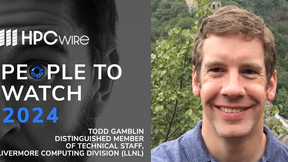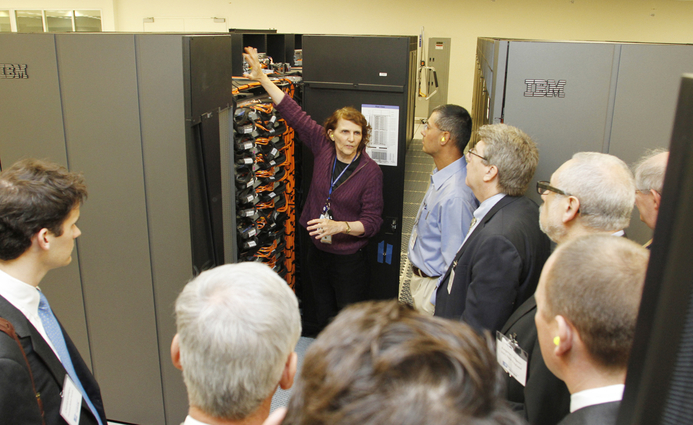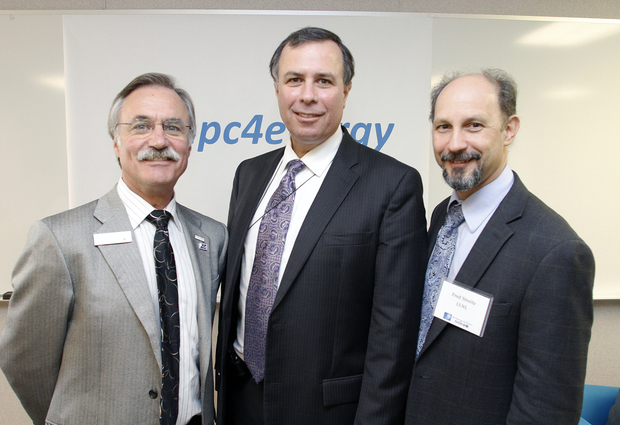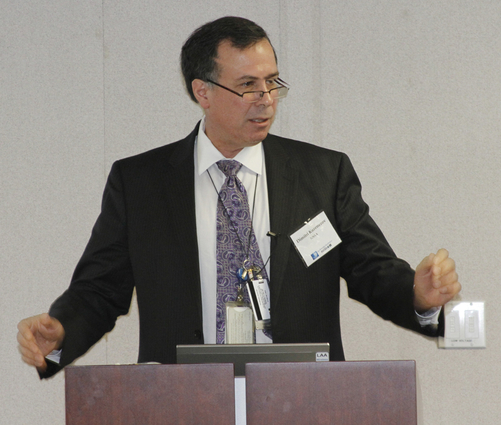Energy companies see bright future for high performance computing collaborations with the Lab
"When you have computing capabilities you didn't have before, you think differently about problems," said Eugene Litinov, an executive with ISO New England, a non-profit electric grid management company. "You can ask questions you didn't think of asking before."
This typified the comments from the energy industry executives and technical leads who attended Monday's "hpc4energy Incubator" workshop in LLNL's High Performance Computing Innovation Center (HPCIC). Six U.S. energy industry projects were selected earlier this year for the pilot incubator program to demonstrate the power of the Lab's computing capabilities to accelerate the development of new technologies. The workshop was held to assess progress six months into the one-year pilot.
In remarks opening the workshop, Director Parney Albright noted that the partnership with industry is a natural extension of the Laboratory's approach to fulfilling its national security missions. "The Lab's culture is about bringing together multidisciplinary teams to work on problems of national importance," Albright said. "Now we want to take some of the capabilities we've developed and put them in the service of the U.S. economy."
The high performance computing (HPC) capabilities at Livermore, he said, "allow you to do things you couldn't even think about before."
Michael McQuade of United Technologies Research Center, who also was representing the Council on Competitiveness, said super storm Sandy is a reminder of the "great challenges of our time" - climate change and affordable clean energy. "Our job is to recognize that," McQuade said. "HPC is one of the primary tools we have to combat climate change."
The hpc4energy Incubator represents a new way for the Laboratory to work with industry and is emblematic of the activities the Livermore Valley Open Campus (LVOC) is designed to foster. Buck Koonce, LLNL's director of Economic Development who led the development of LVOC, served as master of ceremonies for the workshop.
Dimitri Kusnezov, NNSA chief scientist and director of the Office of Science and Policy, noted that the hpc4energy is "more than just about computing."
"What we're here for is to invest in an idea," Kusnezov said. "We cannot continue business as usual. The world is changing. To address these changes we have to take risks. The Livermore Valley Open Campus is such a step."
The six companies presenting in the morning session of the workshop included: Robert Bosch LLC, GE Energy Management, GE Global Research, ISO New England, Potter Drilling, Inc., and United Technologies Research Center. Technical leads discussed how they were using the Lab's computing resources and domain expertise to develop their respective technologies.
Projects include research to improve: Simulations of Advanced Internal Combustion Engines; PSLF Simulation Performance and Capability; Thermal Spallation Drilling; Building System Models to Enable Deep Energy Retrofits; Models for Spray Breakup in Liquid Fuels Combustion, and the Evaluation of Robust Unit Commitment.
Jared Potter of Potter Drilling, a small clean tech startup, said his company is using HPC simulation to improve thermal spallation drilling, a technology for improving gas and oil drilling in both new and existing wells. HPC is allowing the company to reduce the time and costs associated with field trials.
The thermal spallation technology has the potential not only to improve productivity in wells but to create manmade geothermal systems, Jared said, adding that this could provide access to the ultimate energy source. "The first five miles of the Earth's crust has enough energy for the next 100,000 years."
Gary Leonard, an executive with GE Global Research, said that in the course of applying LLNL's HPC resources to work on improving the efficiency of jet engines, "we've started to learn about the physics going on in our jet engines we didn't know about...and we've been building jet engines for 60 years."
A common theme among the industry presenters was that the incubator didn't just provide access to HPC systems, but also to multi-disciplinary lab expertise with experience applying HPC to a broad set of technical problems.
During remarks closing the panel discussion, Albright said the computing ecosystem is what makes the Laboratory unique. "It's not just about hardware and software, it's about the people who know how to use it. Our ultimate goal is to migrate this commodity to the way the U.S. does business. We need to get to the place where HPC changes American productivity."
Contact
Donald B Johnston[email protected]
925-423-4902
Tags
HPC, Simulation, and Data ScienceComputing
HPC Innovation Center
Featured Articles










